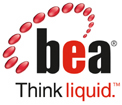
Jakarta EE, formerly Java Platform, Enterprise Edition and Java 2 Platform, Enterprise Edition (J2EE), is a set of specifications, extending Java SE with specifications for enterprise features such as distributed computing and web services. Jakarta EE applications are run on reference runtimes, which can be microservices or application servers, which handle transactions, security, scalability, concurrency and management of the components they are deploying.
An application server is a server that hosts applications or software that delivers a business application through a communication protocol. For a typical web application, the application server sits behind the web servers.

BEA Systems, Inc. was a company that specialized in enterprise infrastructure software products, which was wholly acquired by Oracle Corporation on April 29, 2008.
MKS, Inc is a subsidiary of PTC, Inc. It was previously a multinational independent software vendor that was acquired by Parametric Technology Corporation on May 31, 2011. MKS operated in the Application Lifecycle Management (ALM) and Systems Administration market segments.
WebSphere Application Server (WAS) is a software product that performs the role of a web application server. More specifically, it is a software framework and middleware that hosts Java-based web applications. It is the flagship product within IBM's WebSphere software suite. It was initially created by Donald F. Ferguson, who later became CTO of Software for Dell. The first version was launched in 1998. This project was an offshoot from IBM HTTP Server team starting with the Domino Go web server.
The Oracle Application Server 10g is an integrated, standards-based software platform that forms part of Oracle Corporation's Fusion Middleware technology stack. It is designed to support grid computing and service-oriented architecture (SOA) throughout its lifecycle. The core components of Oracle Application Server include the Oracle HTTP Server, which is based on the Apache HTTP Server, and OC4J, which deploys Java EE-based applications. The latest version of OC4J offers full compatibility with the Java EE 1.4 specifications.

GlassFish is an open-source Jakarta EE platform application server project started by Sun Microsystems, then sponsored by Oracle Corporation, and now living at the Eclipse Foundation and supported by OmniFish, Fujitsu and Payara. The supported version under Oracle was called Oracle GlassFish Server. GlassFish is free software and was initially dual-licensed under two free software licences: the Common Development and Distribution License (CDDL) and the GNU General Public License (GPL) with the Classpath exception. After having been transferred to Eclipse, GlassFish remained dual-licensed, but the CDDL license was replaced by the Eclipse Public License (EPL).
In the fields of information technology and systems management, application performance management (APM) is the monitoring and management of the performance and availability of software applications. APM strives to detect and diagnose complex application performance problems to maintain an expected level of service. APM is "the translation of IT metrics into business meaning ."
Oracle Fusion Middleware consists of several software products from Oracle Corporation. FMW spans multiple services, including Java EE and developer tools, integration services, business intelligence, collaboration, and content management. FMW depends on open standards such as BPEL, SOAP, XML and JMS.
This article is a comparison of notable business integration and business process automation software.
Cape Clear Software, Inc., was a vendor of ESB software, founded in 1999.
Orion Application Server is a Java EE application server developed by Swedish company IronFlare AB, founded by Magnus Stenman and Karl Avedal. First released in 1999, Orion claims to be the first commercially available application server with full Java EE support. The current stable version is 2.0.7 which is compliant with Java EE version 1.3.
A mobile enterprise application platform (MEAP) is a type of mobile application development platform (MADP) that includes a suite of products, frameworks, services, and toolkits to assist in the development of mobile applications. MEAP platforms enable organisations or businesses to develop, test, and deploy applications through the use of standardization and protocols.
Caucho Technology is based in San Diego, CA. It is an information technology company that produces web server software and application server software as well as the originators of Quercus and Hessian open source projects. Caucho Technology was founded in 1998.

WildFly, formerly known as JBoss AS, or simply JBoss, is an application server written by JBoss, now developed by Red Hat. WildFly is written in Java and implements the Java Platform, Enterprise Edition specification. It runs on multiple platforms.
GigaSpaces Technologies Inc., is a privately held software company, established in 2000, with its headquarters located in New York City, and additional offices in Europe, Asia, and Israel.
SysMaster is a platform independent application performance management (APM) solution developed by TmaxSoft. It provides a centralized environment for monitoring and managing a wide range of system components and processes, including system-critical components such as DBMS, middleware and Frameworks. APM solutions help systems operate stably by monitoring the state of applications in real time. SysMaster is designed to be capable of tracing every event that occurs within an integrated IT environment in real time with the purpose of identifying issues that could potentially affect system performance, as they occur, before they actually affect the system.
JEUS is a Korean Web application server which is developed by TmaxSoft. JEUS provides the web application server component of TmaxSoft's middleware-tier framework solution. It has been widely adopted in Korea where it holds the largest (42.1%) share of the market.
OpenFrame is a mainframe rehosting solution developed by TmaxSoft that aims to help customers move existing mainframe assets to the cloud quickly and with minimal risk. It replaces legacy CICS/IMS/JES mainframe engines and shifts business applications written in legacy code like COBOL and PL/I to Linux. This allows reduced licensing costs compared to the mainframe.




